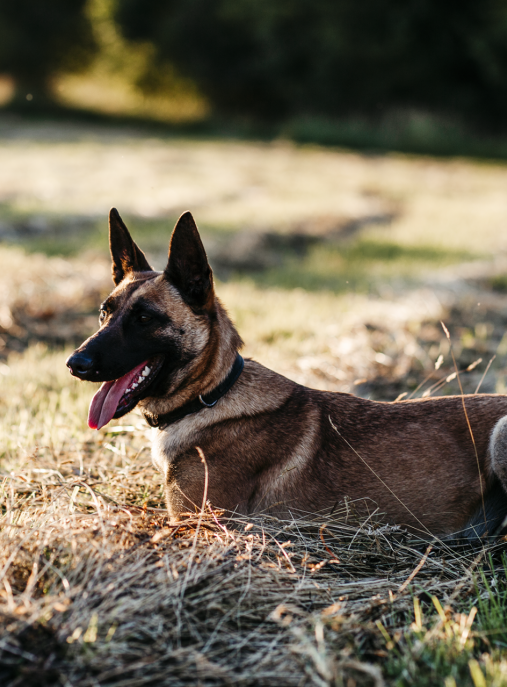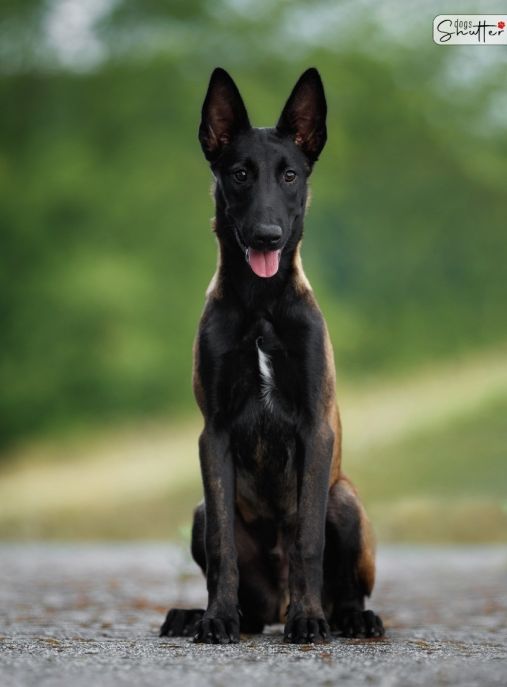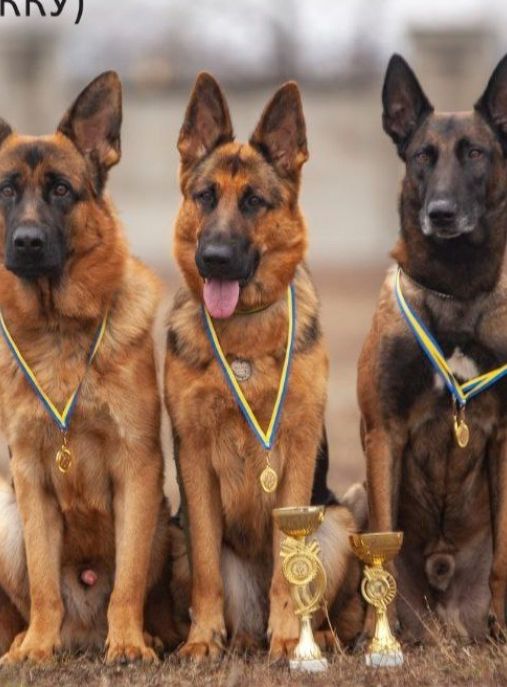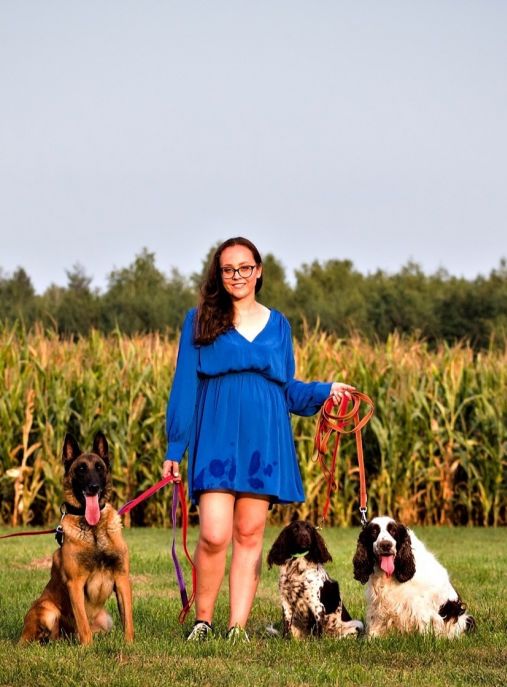The Belgian Shepherd Dog - Malinois, also known simply as the Malinois, is a highly versatile and intelligent breed that hails from Belgium. This breed is a member of the Belgian Shepherd Dog family, which also includes the Groenendael, Tervuren, and Laekenois varieties. The Malinois is widely recognized for its exceptional working abilities, making it a popular choice for various tasks such as police and military work, search and rescue operations, and even as a loyal family companion.
The history of the Belgian Shepherd Dog - Malinois dates back to the late 19th century when Belgian shepherds were selectively bred for their working abilities. The breed's name, Malinois, originates from the Belgian city of Malines, where the breed was first developed. The Malinois was primarily bred for herding and guarding livestock, but its exceptional intelligence, agility, and trainability soon caught the attention of law enforcement agencies and military organizations.
According to the FCI (Fédération Cynologique Internationale) typology, the Belgian Shepherd Dog - Malinois belongs to Group 1: Sheepdogs and Cattledogs (except Swiss Cattledogs). This group comprises breeds that are primarily used for herding and guarding livestock. The Malinois is classified under Section 1: Sheepdogs. It is worth noting that the Malinois is often considered a separate breed from the other Belgian Shepherd Dog varieties due to its distinct characteristics and working abilities.
The Belgian Shepherd Dog - Malinois is a breed that thrives on activity and mental stimulation. These dogs are known for their high energy levels and need for regular exercise. They excel in various dog sports such as obedience, agility, and tracking. Additionally, their exceptional scenting abilities make them excellent candidates for search and rescue work, as well as detection tasks such as narcotics or explosives detection.
In terms of physical characteristics, the Malinois is a medium-sized breed with a well-muscled and athletic build. Males typically stand between 24 to 26 inches (61 to 66 cm) at the shoulder, while females are slightly smaller, ranging from 22 to 24 inches (56 to 61 cm). The breed's weight usually falls between 55 to 75 pounds (25 to 34 kg). The Malinois has a short, dense double coat that provides protection from various weather conditions. The most common coat color is a rich fawn with a black mask, but variations such as mahogany and gray are also seen.
The life expectancy of the Belgian Shepherd Dog - Malinois is generally around 12 to 14 years. However, like any breed, individual dogs' lifespan can vary depending on various factors such as genetics, diet, exercise, and overall health care. It is important to note that the Malinois requires proper socialization, training, and mental stimulation from an early age to ensure a well-rounded and balanced adult dog.
One interesting fact about the Malinois is its exceptional drive and work ethic. These dogs are known for their intense focus and determination, which makes them highly trainable and reliable in various working environments. Additionally, the Malinois has been gaining popularity in dog sports such as competitive obedience and agility due to its impressive athleticism and eagerness to please.
In conclusion, the Belgian Shepherd Dog - Malinois is a remarkable breed that excels in various working roles. With its intelligence, agility, and unwavering loyalty, the Malinois has become a favorite choice for law enforcement agencies, military organizations, and active individuals seeking a versatile and devoted companion. Proper training, socialization, and mental stimulation are crucial for this breed to thrive and reach its full potential.
The Belgian Shepherd Dog - Malinois, often referred to as simply the Malinois, is a breed known for its intelligence, loyalty, and versatility. These dogs are highly energetic and require an active lifestyle to thrive. With proper training and socialization, they can become excellent companions, working dogs, or even competitive athletes.
In terms of their character, Malinois dogs are highly intelligent and eager to please. They are quick learners and excel in various activities such as obedience, agility, tracking, and protection work. Their intelligence also means they can be independent thinkers, so consistent and firm training is essential to establish boundaries and prevent any unwanted behaviors.
One of the defining traits of the Malinois is their high energy level. These dogs have an abundance of stamina and require regular exercise to keep them physically and mentally stimulated. Daily activities such as long walks, runs, or engaging in dog sports are necessary to prevent boredom and potential destructive behaviors. A tired Malinois is a happy Malinois!
Socialization is crucial for this breed. Early and ongoing exposure to different people, animals, and environments is necessary to ensure they grow up to be well-rounded and confident dogs. Proper socialization helps prevent any potential aggression or fear-based behaviors. It is also important to note that Malinois dogs have a strong prey drive, so caution should be exercised when introducing them to smaller animals.
When it comes to raising and training a Malinois, consistency, positive reinforcement, and mental stimulation are key. These dogs thrive on having a job to do, so providing them with tasks or training sessions will keep them engaged and satisfied. They are highly trainable and excel in various dog sports, including obedience, agility, and scent work.
It is important to establish a strong bond with your Malinois through positive reinforcement training methods. Harsh or punitive training techniques can lead to fear or aggression issues. Instead, reward-based training, using treats, praise, and play, will motivate and encourage your Malinois to learn and obey commands.
Due to their high energy levels and intelligence, Malinois dogs are not recommended for first-time dog owners or those who cannot commit to providing them with the physical and mental stimulation they require. They thrive in active households with experienced owners who can provide them with the structure, training, and exercise they need.
In conclusion, the Belgian Shepherd Dog - Malinois is a breed with a remarkable character. They are intelligent, loyal, and highly energetic dogs that require an active lifestyle and mental stimulation. With proper training, socialization, and a dedicated owner, they can become excellent companions, working dogs, or competitive athletes.
The Belgian Shepherd Dog - Malinois, often referred to as the Malinois, is a highly intelligent and energetic breed that requires specific care to ensure their well-being and happiness. Here are some tips on how to care for dogs of this breed, including what to do and what not to do:
1. Exercise: Malinois dogs are known for their high energy levels and need plenty of exercise to stay physically and mentally stimulated. Daily walks, runs, and playtime in a secure area are essential. Engage them in activities like agility training, obedience training, or even dog sports like flyball or dock diving.
2. Mental Stimulation: Along with physical exercise, mental stimulation is crucial for a Malinois. Provide them with puzzle toys, interactive games, and obedience training sessions to keep their minds engaged. Failure to provide adequate mental stimulation can lead to boredom and destructive behavior.
3. Training and Socialization: Early and consistent training is vital for a Malinois. They are highly intelligent and eager to please, making them quick learners. Enroll them in obedience classes and teach them basic commands like sit, stay, and come. Socialize them from a young age by exposing them to various people, animals, and environments to prevent aggression or fearfulness.
4. Grooming: The Malinois has a short, dense coat that requires minimal grooming. Regular brushing with a slicker brush or grooming mitt will help remove loose hair and keep their coat healthy. They shed moderately throughout the year, with heavier shedding during seasonal changes. Bathing should be done as needed, using a mild dog shampoo.
5. Nutrition: Provide a well-balanced diet that meets the nutritional needs of a high-energy breed like the Malinois. Consult with a veterinarian to determine the appropriate portion sizes and choose a high-quality dog food that contains essential nutrients. Avoid overfeeding, as Malinois dogs are prone to weight gain, which can lead to joint problems.
6. Health Care: Regular veterinary check-ups are crucial to ensure the overall health of your Malinois. Vaccinations, parasite prevention, and dental care should be part of their routine. Additionally, be aware of breed-specific health issues such as hip dysplasia and progressive retinal atrophy. Regular exercise and a healthy diet can help prevent obesity-related health problems.
7. Avoid Boredom: Malinois dogs are prone to boredom and can become destructive if left alone for extended periods. Avoid leaving them alone for too long and provide them with interactive toys, treat-dispensing puzzles, or even a companion dog if possible. Mental stimulation and companionship are essential for their well-being.
8. Avoid Harsh Training Methods: Malinois dogs respond best to positive reinforcement training methods. Avoid using harsh or punitive techniques as it can lead to fear or aggression. Reward-based training, using treats, praise, and play, will help build a strong bond with your Malinois and encourage desired behaviors.
9. Secure Environment: Malinois dogs are known for their protective instincts. Ensure your home and yard are secure, with proper fencing and gates to prevent them from escaping. Supervise them around strangers or unfamiliar animals until they are properly socialized.
10. Time and Commitment: Lastly, owning a Malinois requires a significant amount of time, commitment, and dedication. They thrive on human companionship and need an active lifestyle. Be prepared to invest time in their training, exercise, and mental stimulation to ensure they lead a happy and fulfilling life.
Remember, every dog is an individual, and while these tips provide general guidelines, it's important to adapt them to your specific dog's needs. Providing a loving, stimulating, and well-structured environment will help your Belgian Shepherd Dog - Malinois thrive and become a cherished member of your family.
The Belgian Shepherd Dog - Malinois, known for its striking appearance and exceptional working abilities, is often recognized for its distinct coat color. The common color of these dogs is a rich, warm fawn with varying shades that range from a light tan to a deep mahogany. This coloration is one of the defining characteristics of the breed and adds to its overall allure.
The fawn color of the Malinois is typically seen throughout the majority of its body, including the back, sides, and legs. The coat is dense and short, providing a sleek and elegant appearance. The fawn coloration is often accompanied by a black mask that covers the muzzle, giving the dog a distinctive and intense expression. This mask can extend to the ears, highlighting their alertness and attentiveness.
The intensity of the fawn color can vary among individual dogs. Some may have a lighter, more golden hue, while others may exhibit a deeper, reddish-brown tone. The richness of the color is often influenced by genetics and can be influenced by factors such as sunlight exposure and overall health.
In addition to the fawn color, the Malinois may also have some black overlay on its back and tail. This overlay can appear as a series of dark hairs interspersed within the fawn coat, creating a striking contrast. The black overlay is more prominent in some individuals than others, adding to the uniqueness of each dog's appearance.
It is important to note that while fawn is the most common color of the Belgian Shepherd Dog - Malinois, other color variations can occur within the breed. These variations include a solid black coat, as well as a combination of fawn and black known as "sable." However, the fawn color remains the most prevalent and recognizable among Malinois dogs.
The fawn coat of the Malinois not only contributes to its aesthetic appeal but also serves a functional purpose. This coloration allows the dog to blend in with its natural surroundings, making it an excellent working dog in various environments. Whether it is working in the fields, herding livestock, or serving as a police or military dog, the fawn coat of the Malinois provides it with a level of camouflage and adaptability.
In conclusion, the common color of the Belgian Shepherd Dog - Malinois is a rich fawn, ranging from light tan to deep mahogany. This color is often accompanied by a black mask, adding to the dog's intense expression. The fawn coat, with its variations and black overlay, not only enhances the breed's appearance but also serves a functional purpose in its working abilities.
The Belgian Shepherd Dog - Malinois, also known as the Malinois, is a highly energetic and intelligent breed that requires proper care and attention to maintain good health. These dogs are known for their agility, loyalty, and versatility, making them popular in various roles such as police and military work, search and rescue, and competitive sports. To ensure the well-being of a Malinois, it is essential to be aware of the common diseases that affect this breed and provide appropriate care.
One of the most common health issues seen in Belgian Shepherd Dogs - Malinois is hip dysplasia. This condition occurs when the hip joint does not develop properly, leading to joint instability and eventual arthritis. Regular exercise on soft surfaces, maintaining a healthy weight, and avoiding excessive jumping or rough play during the early stages of growth can help reduce the risk of hip dysplasia. Additionally, breeding dogs with certified healthy hips can help minimize the occurrence of this condition in future generations.
Another prevalent health concern in Malinois is progressive retinal atrophy (PRA). PRA is a degenerative eye disease that leads to gradual vision loss and, in severe cases, blindness. Regular eye examinations by a veterinary ophthalmologist can help detect PRA early on, allowing for appropriate management and lifestyle adjustments to accommodate the dog's visual impairment.
Malinois are also prone to developing certain skin conditions, including allergies and dermatitis. These can be triggered by various factors such as food, environmental allergens, or parasites. Regular grooming, including brushing the coat to remove loose hair and debris, can help prevent skin issues. Additionally, providing a balanced diet with high-quality ingredients and avoiding potential allergens can help minimize the risk of skin problems.
Epilepsy is another health concern that affects some Malinois. This neurological disorder causes recurrent seizures, which can vary in severity and frequency. While there is no cure for epilepsy, it can often be managed with medication prescribed by a veterinarian. Regular veterinary check-ups and monitoring of the dog's condition are crucial to ensure appropriate treatment and adjustments to medication if necessary.
To maintain the overall health of a Belgian Shepherd Dog - Malinois, regular exercise is essential. These dogs have high energy levels and require daily physical and mental stimulation. Engaging in activities such as obedience training, agility, or interactive play sessions can help prevent behavioral issues that may arise from pent-up energy.
Proper nutrition is also vital for the well-being of a Malinois. Feeding a balanced diet that meets their nutritional requirements, including high-quality protein sources, is crucial. Avoiding overfeeding and monitoring their weight can help prevent obesity, which can lead to various health problems.
Regular veterinary check-ups are essential for early detection and prevention of potential health issues. Vaccinations, parasite prevention, dental care, and routine blood tests are all part of maintaining the health of a Malinois.
In conclusion, the Belgian Shepherd Dog - Malinois is a remarkable breed with specific health considerations. By being aware of the common diseases that affect this breed and providing appropriate care, including regular exercise, a balanced diet, and routine veterinary check-ups, you can ensure the overall health and well-being of your Malinois companion.
The Belgian Shepherd Dog - Malinois is a highly active and intelligent breed known for its agility, endurance, and versatility. To ensure their overall health and well-being, it is crucial to provide them with a well-balanced and nutritious diet. Proper nutrition plays a vital role in supporting their energy levels, maintaining a healthy weight, and promoting optimal muscle development.
When it comes to feeding a Belgian Shepherd Dog - Malinois, it is important to consider their age, weight, activity level, and any specific dietary requirements or health concerns they may have. Here are some guidelines and advice on how to feed and what to avoid when it comes to this breed's nutrition:
1. High-quality dog food: Choose a premium quality dog food that is specifically formulated for active breeds. Look for a product that lists a high-quality source of animal protein, such as chicken, beef, or fish, as the first ingredient. Avoid foods that contain fillers, by-products, or artificial additives.
2. Balanced macronutrients: Dogs of this breed require a diet that is rich in protein to support their muscle development and repair. Aim for a minimum of 25-30% protein content in their food. Additionally, ensure a moderate amount of healthy fats and carbohydrates to provide them with sustained energy.
3. Controlled portion sizes: Belgian Shepherd Dog - Malinois dogs have a tendency to overeat, which can lead to weight gain and related health issues. Divide their daily food intake into two or three smaller meals to prevent overeating. Consult with your veterinarian to determine the appropriate portion size based on your dog's age, weight, and activity level.
4. Fresh water: Always provide your dog with access to fresh, clean water throughout the day. Hydration is essential for their overall health and helps regulate body temperature, digestion, and nutrient absorption.
5. Treats and supplements: Treats can be a great way to reward your Belgian Shepherd Dog - Malinois during training sessions or as occasional snacks. Opt for healthy, low-calorie treats that are specifically designed for dogs. Additionally, consult with your veterinarian before adding any supplements to your dog's diet, as they may have specific nutritional needs or deficiencies that require supplementation.
6. Avoid harmful foods: Certain foods can be toxic or harmful to dogs and should be strictly avoided. These include chocolate, caffeine, alcohol, grapes, raisins, onions, garlic, avocados, and any products containing xylitol. These foods can cause digestive issues, organ damage, or even be fatal to your dog.
7. Regular exercise: Along with a nutritious diet, regular exercise is crucial for the overall health and well-being of Belgian Shepherd Dog - Malinois dogs. They thrive on physical activity and mental stimulation. Engage them in daily walks, runs, play sessions, and training exercises to keep them physically and mentally stimulated.
Remember, every dog is unique, and their nutritional needs may vary. It is always recommended to consult with your veterinarian to create a personalized feeding plan for your Belgian Shepherd Dog - Malinois based on their specific requirements and health conditions. By providing them with a well-balanced diet and an active lifestyle, you can ensure that your beloved companion remains healthy, happy, and full of vitality.






























